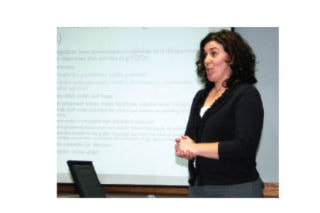A meeting was held by the Nadina Forest District last week in order to seek the public's opinion on possible changes to the visual quality objectives in the lakes timber supply area.
A number of local residents attended the meeting to hear the proposal and voice their support or express their concerns about the proposed increase of logging in local designated scenic areas.
Many forest licensees in the lakes timber supply area are investigating the possibility of making changes to the current visual quality objectives due to the mountain pine beetle epidemic.
This will allow for increased logging of dead pine trees in and around Taltapin Lake, Pinkut Lake, Helene Lake, Babine Lake, Bird Lake, Decker Lake and Burns Lake.
Agathe Bernard, Nadina stewardship officer along with Josh Pressey from the Nadina Forest District and Dan Rollert operations superintendent from Hampton's Babine Forest Products spoke at the meeting.
Pressey said that a decision will be made throughout the next few months using the input that is gathered from the public.
Bernard said that about 90 per cent of the pine trees available for harvest in the lakes timber supply area are dead.
"We expect that by 2020 this pine will no longer be economically viable, so after 2020 harvest levels will be much lower," she said.
"For the next 10 years the harvest must focus on pine trees," she said.
Visual quality objectives are managed by the government and limit the size, shape and number of cut blocks that can be present at in one time and can only be amended through an order made under government actions regulations which requires public consultation.
The forest planning and practices regulation defines five categories of visual quality objectives which are; preservation - very small in scale and not easily distinguishable from the pre-harvest landscape; retention - alteration is difficult to see, small in scale and natural in appearance; partial retention - easy to see, small to medium in scale and not geometrical in shape; modification - very easy to see, large in scale and natural in appearance and maximum modification - very easy to see, very large in scale and geometrical in shape.
"There are no maximum modification visual quality objectives in the lakes timber supply area," Bernard said.
Retention visual quality objectives apply to approximately 3.5 per cent of the lakes timber supply area harvesting land base while modification visual quality objectives apply to approximately 5.9 per cent of the area.
Rollert said that they were hoping to see changes made to the scenic areas, increasing them from partial retention to modification.
"We are not asking for maximum modification or no visual quality restraints. We need to be able to stay harvesting that dead pine for as long as we can," he added.
He went on to say that the benefits of changing the visual quality objects would also include reduced fuel loading from dead and fallen pine.
"The fires, like the Binta Lake fire were extremely hot, removing the dead pine doesn't decrease the chance of fires as they will always occur, however it does decrease the intensity of the fires. After a really intense fire you get soil sterilization, where not a lot grows back. You can't even grow grass as the soil is vaporized," Rollert said.
A local tourist operator said he was concerned about relaxing visual quality objectives.
"It sets a dangerous precedence. Red trees were a real hard sell to tourists. The grey and black trees with a green understory are okay, they are not as good as green, but not bad from a tourism point of view. All of this is better than a cut block," he said.
Rollert went on to say that they are 100 per cent open to sitting down with local tourism operators to come up with suggestions and address any concerns.
The questionnaire can be picked up from the Nadina Forest District office in Burns Lake and need to be filled out and returned by Feb. 15, 2011.
